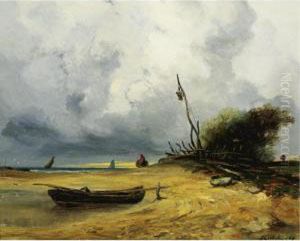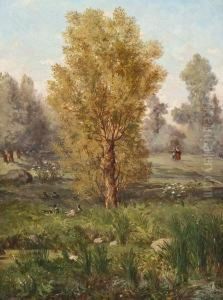Jules Michelin Paintings
Jules Michelin was a French landscape painter born in 1826 in Marseilles. His full name was Jules Adolphe Aimé Louis Michelin, and he was active during the 19th century, a period characterized by a diversity of artistic movements including Romanticism, Realism, and Impressionism. While Michelin's work is not as widely recognized as some of his contemporaries, he contributed a rich body of work that captured the French countryside and urban vistas with a particular sensitivity to atmospheric effects and light.
Michelin was trained in the classical tradition of landscape painting, and his work often reflected a meticulous attention to detail and a strong sense of composition. He was particularly skilled in the use of oil paints, which allowed him to achieve a depth of color and a subtlety in his depictions of natural and architectural elements. His landscapes are notable for their serene and often idyllic quality, evoking a sense of calm and tranquility.
Throughout his career, Jules Michelin participated in various exhibitions, including the Paris Salon, which was the official art exhibition of the Académie des Beaux-Arts in Paris. His participation in such esteemed exhibitions indicates that his work was held in considerable regard by his peers and the art establishment of his time. Despite this, Michelin did not achieve the same level of fame as some of his contemporaries, and as a result, his work is less well-documented and studied in the present day.
Jules Michelin's artistic legacy includes his influence on local painters and the preservation of his works in regional museums and private collections. His paintings continue to be appreciated for their beauty and historical value, offering insight into the French landscape tradition of the 19th century. Jules Michelin passed away in 1886, leaving behind a body of work that continues to be of interest to art historians and collectors who are passionate about French landscape painting of this era.

